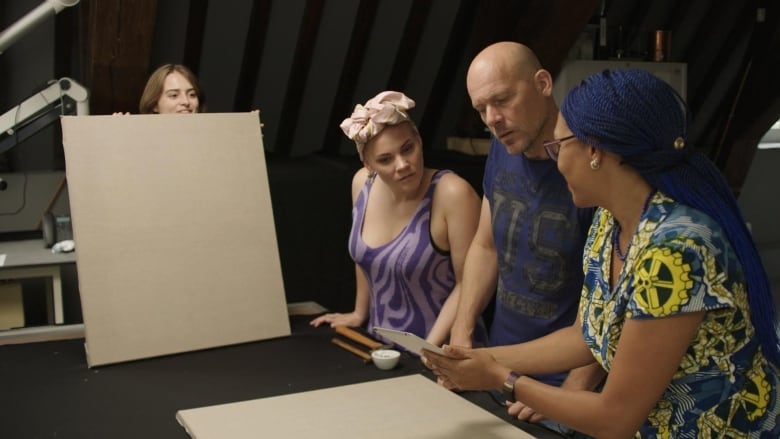How reality TV is bringing back Vermeer paintings that have been lost for centuries
The New Vermeer has artists re-imagine lost works using only short written descriptions


A reality TV show in the Netherlands is giving new life to old paintings, some of which haven't been seen in hundreds of years.
Called The New Vermeer, the hit series challenges artists to recreate the six lost works of 17th-century Dutch painter Johannes Vermeer.
Vermeer is one of the most famous Dutch artists of all time, but only about three dozen of his paintings are known to exist. Six others are lost — one stolen from a museum decades ago, and others only known from brief written descriptions gleaned from inventories or auction records from around the time of his death in 1675.
"These things have never even been seen," artist Maudy Alferink, a contestant on the show's first episode, told As It Happens host Nil Köksal. "It's only on a piece of paper — a small sentence — with the information."
Those small sentences are all The New Vermeer contestants have to go by as they work to re-imagine a masterpiece from scratch.
6 lost paintings, 6 episodes
The six-episode series launched on Feb. 12, and it's already a huge hit in the Netherlands, says Josse van Rhee, a spokesperson on Omroep MAX, the channel that airs it.
Each of the three episodes that have aired so far have seen viewerships of between 1.2 million and 1.3 million, he said. The Netherlands has a population of 17.5 million.
The show's launch coincided with the opening of an exhibit at Amsterdam's Rijksmuseum that features 28 Vermeers — the largest collection of the artists' work ever shown. The exhibit already sold out.

Each episode of The New Vermeer pits two artists against each other to re-create the same work.
They get four months to create the piece, and during the process, they can consult with experts and curators who coach them about the Vermeer's style and technique, as well as historically accurate materials, props and settings.
For Alferink — a self-taught painter — seizing this opportunity was a no-brainer.
"That's the way I taught myself to paint. I looked at Caravaggio, Vermeer, Rembrandt, all the classical masters … and now I get the opportunity to be with all these specialists," she said.
"It was really special, so I didn't have to think twice."
In the first episode, Alferink competed against artist Nard Kwast.
He's always had a passion for the works of the old masters, he says, and has a lot of experience making reproductions of their work — though never before without a reference point.
This time, all he had to go on was a description that roughly translates to: A lord washing his hands in a room with other figures.
Kwast says he started by doing his homework. He studied the artist's work intensely, both in books and museums, asking himself: What makes a Vermeer a Vermeer?
"I have to really dive into this," he said.

Kwast says he's always appreciated Vermeer for his precision, the way he works with light, and his ability to depict these still and quiet moments.
But through the show, he's been able to observe in detail just how much the artist improved himself and refined his technique throughout his career.
"I have much more appreciation for his work now after this whole program," he said. "It's so genius what he does. It's so skilful also. But there is also something special about him."

Mysterious relationships
In the end, both artists came up with similar scenes in which a maid washes the lord's hand while another woman looks on from behind. The specific details differ, but both paintings imply a relationship — or perhaps a tension — between the three characters.

Alferink does this through symbolism, painting lemons on the table, and a servant woman entering the room with a basket of peaches.
"Lemons, they mean it's like a sour love or like a love that has gone wrong. And peaches, they mean sensuality and fruitfulness," Alferink said. "So there's storyline between the three people in there and ... as a viewer, you're trying to figure out what's going on."

In Kwast's version, instead of peaches, the woman is carrying a letter. The maid washing the lord's hands casts her a knowing look, almost as if to warn: "Maybe this is not the right moment to come here," he said.
"I wanted to create some kind of tension between these people," Kwast said. "To be honest, I'm the creator of this painting, but I'm not really sure what's happening. But I know there is something happening. And I like this more than [if it was] totally clear."
Making art accessible
Both Alferink and Kwast are blown away by all the attention the show is getting.
"It's, for me, a little bit surreal," Kwast said. "I'm really feeling proud."
Alferink hopes it will help introduce more people not only Vermeer's work, but also the art world in general. Already, she said she's received emails from people who were inspired by the show to take up painting themselves.
"I hope that is motivating people to visit more museums," she said. "I really hope so."
The New Vermeer is not available for viewing in Canada, but its accompanying web series, Masterclass, is on YouTube. Anyone can tune into the digital version of the Rijksmuseum exhibit here.
Interview with Maudy Alferink produced by Katie Geleff.

